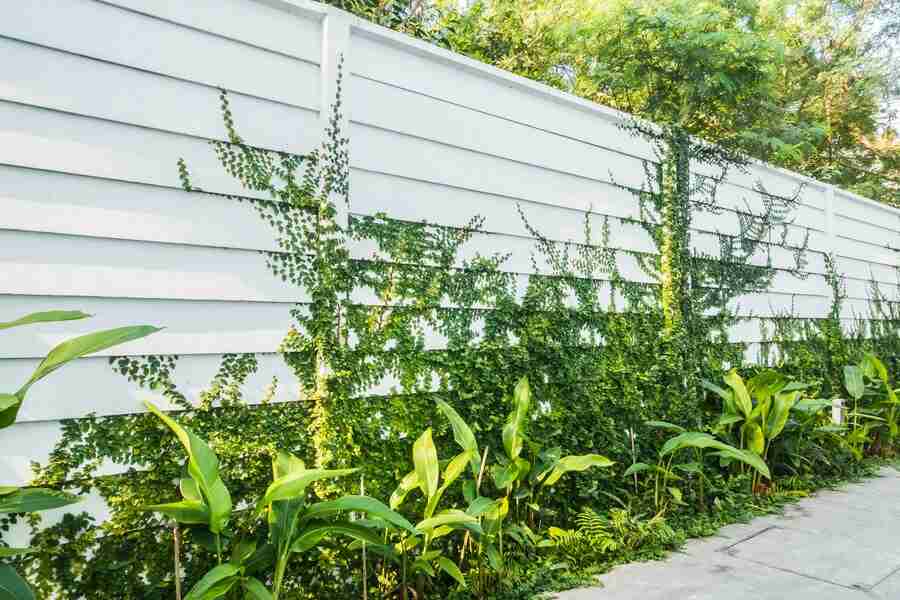
The beauty of nature can transform even the most mundane structures into enchanting features of a landscape. Among the many ways to enhance outdoor spaces, adding greenery to your fence can bring a touch of natural elegance and vitality to your surroundings. Whether you’re seeking privacy, aesthetics, or a blend of both, climbing vines and ivy offer versatile solutions that complement various architectural styles and preferences.
Climbing vines and ivy not only soften the harsh lines of fences but also create a living tapestry that evolves with the seasons. From delicate blooms to vibrant foliage, these green companions add depth and character to any outdoor setting, inviting a sense of tranquility and harmony into your backyard sanctuary.
Choosing the Right Climbing Plants
Selecting the perfect climbing plants for your fence involves considering factors like climate, sunlight exposure, and personal preferences. Opt for species well-suited to your region’s weather conditions to ensure they thrive year-round. Additionally, take note of how much sunlight your fence receives throughout the day, as some plants prefer full sun while others thrive in partial shade.
Consider the growth rate and ultimate size of the plants, ensuring they won’t overwhelm your fence or neighboring plants. Take into account whether you desire flowering vines for bursts of color or evergreen varieties for year-round foliage. Ultimately, choose plants that align with your aesthetic vision and maintenance capabilities, ensuring a harmonious integration into your outdoor space.
Benefits of Adding Greenery to Your Fence
Adding greenery to your fence offers numerous advantages that go beyond mere aesthetics. From enhancing privacy to promoting biodiversity, here are five compelling reasons why incorporating climbing plants into your fence design can transform your outdoor space:
- Privacy Enhancement: Climbing vines and ivy create a natural barrier, shielding your outdoor area from prying eyes and creating a secluded sanctuary where you can relax and unwind.
- Improved Air Quality: Greenery on your fence helps filter out pollutants from the air, promoting a healthier environment for you and your family to enjoy.
- Habitat for Wildlife: Climbing plants attract beneficial wildlife such as birds, butterflies, and bees, providing essential habitat and food sources for these creatures.
- Temperature Regulation: The dense foliage of climbing plants helps regulate temperatures, providing shade in the summer and insulation in the winter, resulting in a more comfortable outdoor environment.
- Eco-Friendly Solution: By incorporating greenery into your fence design, you’re contributing to environmental sustainability by reducing carbon emissions, conserving water, and promoting a greener urban landscape.
Adding greenery to your fence not only enhances the beauty of your outdoor space but also offers a multitude of practical benefits that contribute to a healthier, more sustainable environment for both you and future generations to enjoy.
Types of Climbing Vines for Fence Enhancement
When it comes to enhancing your fence with climbing vines, selecting the right species is crucial for achieving your desired aesthetic and functional goals. Below are five types of climbing vines that can transform your fence into a verdant masterpiece:
- Clematis: Known for its stunning array of colorful flowers, clematis adds a vibrant touch to any fence. With varieties ranging from delicate pastels to bold primaries, there’s a clematis to suit every taste and color scheme.
- Jasmine: Renowned for its sweet fragrance, jasmine vines infuse your outdoor space with a delightful aroma. Whether used to adorn a trellis or cascade over a fence, jasmine adds a touch of romance and charm to your surroundings.
- Passionflower: With its intricate, exotic blooms, the passionflower vine is a captivating addition to any fence. From its unique floral structure to its rich symbolism, this vine brings an element of intrigue and fascination to your outdoor landscape.
- Trumpet Vine: Vibrant and eye-catching, the trumpet vine boasts clusters of orange flowers that attract hummingbirds and butterflies. Perfect for adding a pop of color and attracting pollinators to your garden, this vigorous vine thrives in sunny locations.
Creating a Natural Privacy Barrier with Ivy
Ivy, with its dense foliage and vigorous growth, is an excellent choice for creating a natural privacy barrier along your fence line. Whether you’re looking to shield your outdoor space from prying eyes or simply want to enjoy a secluded retreat, ivy offers both beauty and functionality.
Plant ivy along your fence, allowing it to climb and spread, gradually forming a lush green screen that provides privacy year-round. As the ivy matures, its thick foliage acts as a sound barrier, reducing noise pollution and creating a tranquil atmosphere in your backyard sanctuary. With its low maintenance requirements and ability to thrive in various conditions, ivy is a versatile option for enhancing privacy while adding timeless elegance to your outdoor space.
Tips for Planting and Maintaining Climbing Vines
When planting and maintaining climbing vines, it’s essential to follow best practices to ensure their health and vitality. Here are some tips to help you get started and keep your vines thriving:
- Choose the Right Location: Select a sunny spot with well-drained soil for optimal growth. Ensure the location provides adequate support for climbing, such as a trellis or fence.
- Proper Planting Depth: Plant vines at the correct depth, with the root ball slightly below the soil surface. This encourages strong root development and stability.
- Regular Watering: Provide consistent moisture, especially during the establishment phase. Water deeply and evenly, ensuring the soil remains moist but not waterlogged.
- Pruning and Training: Regular pruning is essential to control growth and shape the vine. Remove dead or damaged branches and train the vine to climb using a trellis or support structure.
- Monitor for Pests and Diseases: Keep an eye out for common pests and diseases that may affect your vines. Treat any issues promptly to prevent widespread damage.
By following these tips for planting and maintaining climbing vines, you can ensure they thrive and beautify your outdoor space for years to come.
Incorporating Climbing Plants into Fence Design
Integrating climbing plants into your fence design offers endless possibilities for creativity and customization. Consider incorporating built-in planters or trellises directly into your fence structure, providing dedicated spaces for vines to climb and flourish. This seamless integration not only enhances the visual appeal of your fence but also maximizes space and functionality in your outdoor area.
Experiment with different materials, such as wood, metal, or composite, to complement your chosen climbing plants and overall aesthetic. Additionally, strategically placing climbing plants along specific sections of your fence can draw attention to focal points or architectural features in your outdoor space, creating visual interest and depth.
Maximizing Space with Vertical Gardening Techniques
Climbing plants offer a fantastic opportunity to embrace vertical gardening techniques, maximizing space and productivity in your outdoor area. Utilize wall-mounted planters, hanging baskets, or vertical garden structures to create stunning living walls that cascade with lush foliage and vibrant blooms.
Vertical gardening not only adds a decorative element to your fence but also allows you to grow a wide variety of plants, from herbs and vegetables to cascading flowers and trailing vines. Whether you’re working with limited square footage or simply looking to make the most of your vertical space, incorporating climbing plants into your fence design can transform even the smallest outdoor area into a thriving green oasis.
Sustainable Solutions
In today’s rapidly changing world, embracing sustainable solutions for fence greenery is imperative to minimize our environmental impact while enhancing the beauty of our outdoor spaces. Here are five actionable steps towards a greener approach:
- Choose native plants: Opt for native climbing plants that are well-adapted to your local climate and soil conditions. Native species require less water and maintenance, reducing the need for artificial inputs and preserving local biodiversity.
- Incorporate recycled materials: Select fence materials made from recycled or reclaimed sources, such as reclaimed wood or composite materials. By giving new life to existing materials, you help reduce waste and lower the demand for virgin resources.
- Implement water-efficient irrigation: Install drip irrigation systems or rainwater harvesting techniques to minimize water consumption and promote efficient use of this precious resource. Water-efficient irrigation not only conserves water but also reduces the risk of overwatering and water runoff.
- Practice organic gardening methods: Embrace organic gardening practices, such as composting and natural pest control, to maintain a healthy ecosystem in your outdoor space. Avoiding synthetic chemicals helps protect pollinators and beneficial insects while fostering a balanced and resilient environment.
Incorporating these sustainable solutions into your fence greenery not only enhances the beauty of your outdoor space but also contributes to the preservation of our planet’s resources for generations to come. Let’s take proactive steps towards a greener tomorrow, one fence at a time.
Integrating climbing vines and ivy into your fence design offers a myriad of benefits, from enhancing privacy and aesthetics to promoting biodiversity and sustainability. By carefully selecting the right plants and incorporating them thoughtfully into your outdoor space, you can create a lush, green oasis that enriches your surroundings and contributes to a healthier environment. Whether you’re seeking to create a natural privacy barrier, elevate the visual appeal of your outdoor area, or simply harness the power of nature for fence beautification, climbing plants offer versatile solutions that cater to your preferences and needs.
At High Quality Fence, we understand the importance of creating outdoor spaces that are both functional and beautiful. Contact us today at 209-815-9015 or email us at info@highqualityfence.com to learn more about how we can help you enhance your fence with high-quality materials and expert craftsmanship. Let us turn your vision of a green sanctuary into reality, where nature and design seamlessly intertwine.
 Se Habla Español
Se Habla Español


